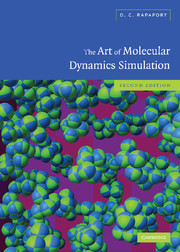Book contents
- Frontmatter
- Contents
- Preface to the first edition
- Preface to the second edition
- About the software
- 1 Introduction
- 2 Basic molecular dynamics
- 3 Simulating simple systems
- 4 Equilibrium properties of simple fluids
- 5 Dynamical properties of simple fluids
- 6 Alternative ensembles
- 7 Nonequilibrium dynamics
- 8 Rigid molecules
- 9 Flexible molecules
- 10 Geometrically constrained molecules
- 11 Internal coordinates
- 12 Many-body interactions
- 13 Long-range interactions
- 14 Step potentials
- 15 Time-dependent phenomena
- 16 Granular dynamics
- 17 Algorithms for supercomputers
- 18 More about software
- 19 The future
- Appendix
- References
- Function index
- Index
- Colophon
8 - Rigid molecules
Published online by Cambridge University Press: 28 February 2011
- Frontmatter
- Contents
- Preface to the first edition
- Preface to the second edition
- About the software
- 1 Introduction
- 2 Basic molecular dynamics
- 3 Simulating simple systems
- 4 Equilibrium properties of simple fluids
- 5 Dynamical properties of simple fluids
- 6 Alternative ensembles
- 7 Nonequilibrium dynamics
- 8 Rigid molecules
- 9 Flexible molecules
- 10 Geometrically constrained molecules
- 11 Internal coordinates
- 12 Many-body interactions
- 13 Long-range interactions
- 14 Step potentials
- 15 Time-dependent phenomena
- 16 Granular dynamics
- 17 Algorithms for supercomputers
- 18 More about software
- 19 The future
- Appendix
- References
- Function index
- Index
- Colophon
Summary
Introduction
The elementary constituents of most substances are structured molecules, rather than the spherically symmetric atoms treated in previous chapters. The emphasis on simple monatomic models is justified for a number of reasons: the dynamics are simpler, thereby making life easier for newcomers; it reflects the historical development of the field, since the original work establishing the viability of the MD approach as a quantitative tool dealt with liquid argon [rah64]; and once the basic techniques have been mastered they can be extended to a variety of more complex situations. In this chapter we discuss the first of these excursions – to molecules constructed from a rigidly linked atomic framework. This approach is suitable for small, relatively compact molecules, where rigidity seems a reasonable assumption, but if this is not true then motion within the molecule must also be taken into account, as we will see in later chapters. There is really no such thing as a rigid molecule, but from the practical point of view it is a very effective simplification of the underlying quantum problem; the model also does not account for chemical processes – no mechanism is provided for molecular formation and dissociation.
The chapter begins with a summary of rigid-body dynamics, but with a slightly unfamiliar emphasis. In treatises on classical mechanics Euler angles play a central part [go180]; while they provide the most intuitive means for describing the orientation of a rigid body and are helpful for analyzing certain exactly soluble problems, in numerical applications they actually represent a very poor choice.
- Type
- Chapter
- Information
- The Art of Molecular Dynamics Simulation , pp. 199 - 244Publisher: Cambridge University PressPrint publication year: 2004



